Everyone knows the power a fresh start has. It makes us feel confident, even overly capable of achieving whatever goal is in our sights. How many mediocre students do you know from high school who went on to get straight A’s through college? Probably more than you realize. A simple change of scenery and a clean slate is all many students need to discover they are capable of excelling.
A fresh start is a great feeling to have, and research confirms it has a powerful impact on our aspirations and behaviors. As a result, many psychologists, counselors, and goal-minded entrepreneurs are trying to apply the Fresh Start Effect to improve their lives or others.
But what impact can the Fresh Start Effect have in marketing? Some savvy marketers are already using it to encourage their audience to act and convert, whether they know it or not. Khalid wrote about creating a conversion plan for peek seasons and how that can help you generate more revenue. In this article, I will discuss the fresh-start effect, how it inspires people to act, and how marketers can use it to drive conversions.
The fresh-start effect: What pushes us to make new goals?
Complacency is a defining characteristic in a lot of people. Everyone wants to make changes to improve their health, social position, finances, and relationships, but more than often go year after year without taking any real steps to do it.
For most people, the driving force behind this inaction is self-perception. We focus on our past mistakes and let them convince us that we can’t do anything differently. Our failures and imperfections become a part of our identity.
The self-perception problem can be a challenge to overcome, but there are certain events that inspire us to look past our current or past imperfections and set new goals. These are called temporal landmarks.

Probably the most obvious example of a temporal landmark is New Years. It’s an annual disruption to the mundane that opens the door for us to start over. It inspires people to set new goals — even if we don’t ultimately keep them.
But other memorable dates in a person’s life can serve the same purpose. Everyone remembers the day they got in a car accident, won the lottery, or their child was born. Even if you got in a car accident years ago, but the day details are likely etched in your mind a lot more than what you were doing at lunchtime a week and a half ago.
Day-to-day life is mundane, making it nearly impossible to think back and remember what you had for lunch last week. But when a temporal landmark occurs, suddenly everything about that day, even your boring routines, stay crystal clear in your mind for the long term.
Researcher Michael S. Shum explains that temporal landmarks initiate new periods of clarity in our lives, that “emerge from and stand in marked contrast to the seemingly unending stream of trivial and ordinary occurrences that happen to us everyday.”
Whether they come from the calendar (National holidays, the back to school season, etc.) or other meaningful life events, temporal landmarks help us form memories and create new goals.

Researchers from University of Pennsylvania dug deeper into temporal landmarks and saw they are a powerful way to motivate aspirational behavior.
Calling it the “Fresh Start Effect,” they found that people are able to overlook their past imperfections and ordinary occurrences of their daily lives on days that serve as temporal landmarks. As a result, they take more actions to create change, including setting goals and looking for helpful resources to achieve them.
A drug overdose, for example, would be an important temporal landmark that initiates the Fresh Start Effect. When someone overdoses, they’ve reached their lowest point and have a near-death experience. Not only is it memorable, it’s an opportunity for a fresh start because there’s nowhere left to go from there but up. It’s easy to see how drug rehab centers can target their marketing strategy to encourage people to seek treatment after such an event.
Applying the Fresh Start Effect to conversion marketing
Drug rehab centers aren’t the only business type that can take advantage of the Fresh Start Effect to encourage audiences to convert. Temporal landmarks can help encourage behavior that leads to more conversions, better sales, higher retention, and more for every kind of business.
Here are 5 steps you can take to identify temporal landmarks relevant to your business niche and get the most out of the Fresh Start Effect for conversion marketing.
Step 1: Think beyond New Year: Identify the right temporal landmarks
New Year is definitely the most memorable temporal landmark that initiates the Fresh Start Effect. But it’s not the only occasion throughout the year that encourages people to set new goals and start new things.
As a marketer, you’ll want to identify other temporal landmarks that are relevant to your business. Temporal landmarks you might use include:
- Other federal holidays
- Birthdays
- Start of the school year
- Start of sports seasons
These are all general options — there are likely other very specific temporal landmarks that are relevant to your business. Here are a few examples of temporal landmarks for different business models:
| Business | Temporal Landmark |
| SEO expert | Google algorithm update |
| Travel accommodations app | Spring break |
| Bookkeeping software | A new financial quarter |
| Insurance company | Having a baby |
| Life coach | A divorce |
Most marketers take advantage of calendric temporal landmarks to inspire action in their audience. If you want to really stand out, identify temporal landmarks that are unique to your niche that you can use to segment and inspire your audience. They can also be something you create and point out to your audience to inspire them.
Usually, it’s hard to target your marketing message to your audience’s most relevant temporal landmarks unless you gathered a lot of information about them in the signup process.
No one’s saying you should ask your email subscribers to offer up their birthday, anniversary, the day their kids were born, etc., despite the fact that those are valuable temporal landmarks to use for segmentation. [editor note: read more on how to create e-commerce emails that actually work and tips to create an engaging email marketing campaign]
But that doesn’t mean you can’t address them as part of your content marketing strategy to attract people to your blog and other content.
Allstate’s content marketing strategy is a great example of this in action. They have a whole section of blog posts and resources related to life’s big milestones: buying a home, getting married, expecting a baby, an empty nest.
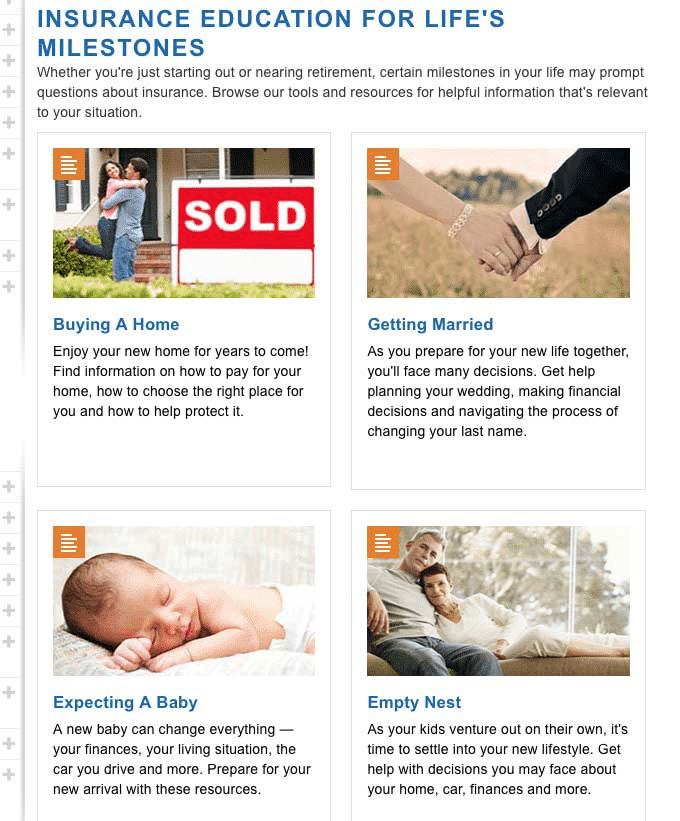
Creating content based on these temporal landmarks can help them drive traffic from SEO, social media, etc.
They create a variety of content around these life milestones, and highlight their services as solutions — encouraging their audience to act and convert:
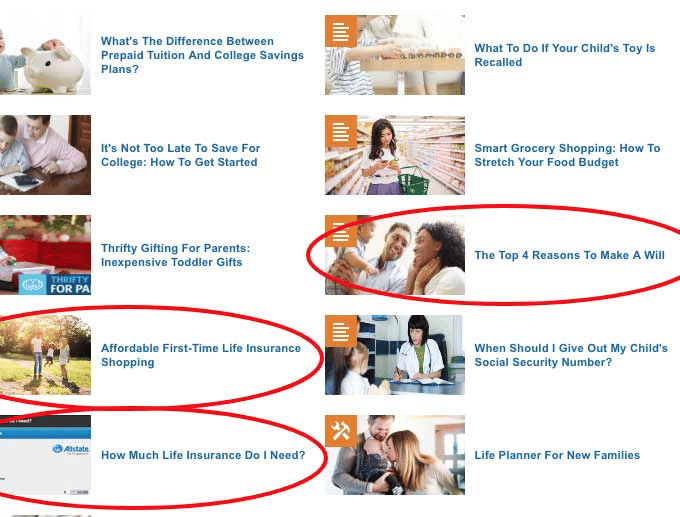
Once you’ve identified the most relevant temporal landmarks for your audience, you’re ready to build a marketing message around it.
Step 2: Redevelop the pain points your content addresses
As a seasoned marketer, you’ve already positioned your products/services to address your audience’s needs/desires. But if you want to really get the most out of the inspirational impact of temporal landmarks, you should take a step back and redevelop your marketing message with them in mind.
Start by focusing on goals your audience wants to achieve but think they can’t. These are probably some of the existing pain points you built from your buyer personas. Then, position your products/services as a solution, but use temporal landmarks to motivate your audience.
Here’s an example of this in action from financial management tool Mint:
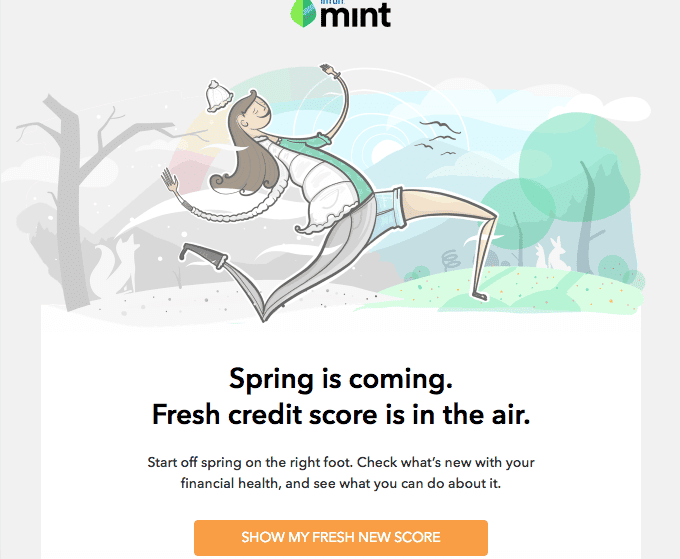
This email has all the elements Mint needs to benefit from the Fresh Start Effect:
- An unmet goal (better financial health)
- A product or service that can help (a fresh new credit score)
- A temporal landmark (a fresh season that symbolizes new beginnings).
That’s a simple example of aligning your existing marketing message with a temporal landmark to inspire action. But there are other creative opportunities beyond this.
Next you can move onto encouraging aspirational behavior that might not have been a part of your audience’s existing pain points.
Here’s an example from meditation app Headspace:
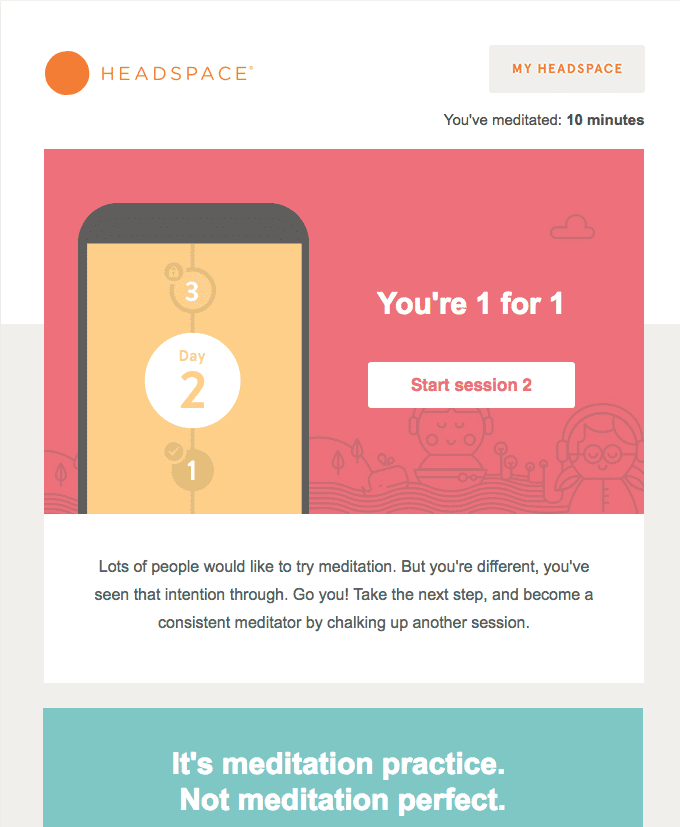
Most people who download and try out a new app like Headspace do it because of mild curiosity, not with goal-setting aspirational behaviors in mind.
Headspace sends out this email after someone completed their first 10 minutes of mediation. It highlights that they already took the first step to becoming a consistent meditator, setting them apart from everyone else who hasn’t tried at all. That’s the temporal landmark they leverage to encourage people to try and pay for more meditation sessions.
Use temporal landmarks like this to help your audience realize new desires and goals.
Step 3: Relate to your audience through temporal landmarks
Once you’ve identified relevant temporal landmarks for your audience, how can you use them to encourage your audience to act?
The “Fresh Start Effect” researchers identified two main ways temporal landmarks affect online behavior. In their laboratory experiments, they prompted some participants to reflect on the meaningfulness of the 2014 New Year. They clicked on three times as many goal-related websites and spend 46% more time reading them.
Here’s the takeaway for marketers: Use temporal landmarks in your marketing message as a way to relate to your audience and encourage them to act.
This targeted Facebook birthday ad is a good example of this:
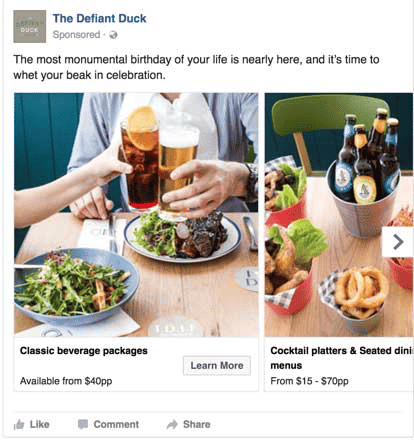
You can use temporal landmarks to tap into your audience’s sentimental side and encourage engagement. Animoto does this in their “Make 2017 Your Year of Video” email:
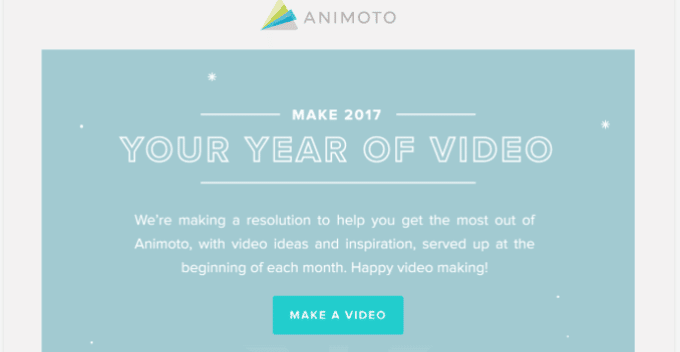
In it, they offer suggestions on how to document your next year through video and recap the previous year:
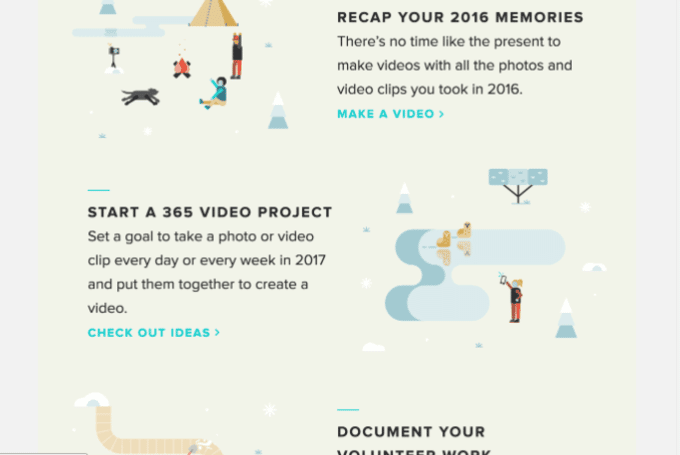
Use the sentimental power of temporal landmarks to encourage your audience to act: become a customer, use your services, etc.
Step 4: Encourage goal pursuit with your customers
Reminding your audience of temporal landmarks encourages them to act on aspirational behaviors. But the Fresh Start Effect researchers also found that people prefer to be reminded of goals they’re pursuing on temporal landmarks.
For example:
- When they labeled March 20th the first day of spring (instead of the third Thursday in March), 354% more people chose that day to receive reminders.
- When they labeled May 14th the first day of summer break, 657% more university students chose that day to receive reminders.
In conversions optimization, you can use the Fresh Start Effect as part of your communication strategy, either through the subscription process or to encourage goal pursuit.
Duolingo does a good job of encouraging goal pursuit using temporal landmarks:
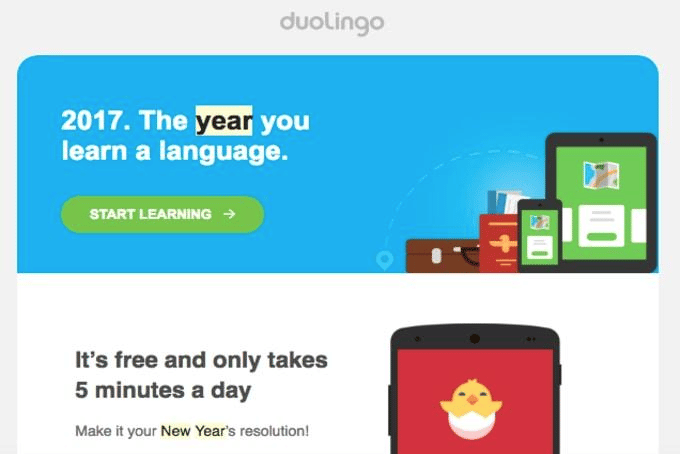
You can also incorporate temporal landmarks into the conversion process, exactly like the researchers did with their studies. Start of the week, month, year, or semester also serve as “mental accounting periods” that help people distance themselves from past imperfections and pursue new goals.
The Fresh Start Effect researchers looked into how these mental accounting periods affected people’s exercise habits. Seven percent of people are more likely to exercise after a birthday, and:
- 33% at the beginning of the week
- 14% at the beginning of the month
- 11% at the beginning of the year
- 47% at the beginning of the semester
You can apply the same principles to any goal-pursuing venture related to your business.
So for example, an online investing tool like Betterment and Wealthfront that caters to college-age investors can include recurring payment options that land on these temporal landmarks. That would encourage people to sign up and pursue these goals.
Step 5: Maintain momentum with your audience
The gym’s always packed in January but we all know the things thin out by March.The motivation that comes from the Fresh Start Effect doesn’t last forever.
If you want to maintain momentum with your audience and encourage customer retention, you have to fight back against the factors that cause people to abandon their goals.
Research into New Year’s goal keeping has shed some light on the factors that help people succeed, namely more stimulus control, reinforcement and willpower. Marketers are positioned to offer positive reinforcement and encourage willpower with their content marketing strategy.
Even a simple follow up on another temporal landmark in your subscriber’s life can serve this purpose — like this birthday greeting from a yoga business:

Don’t look at temporal landmarks as a one time opportunity to encourage your audience to ask. Just like with any other marketing strategy, nurture your audience by reminding them of their goals and leveraging other temporal landmarks to inspire continued commitment to your business.
Wrapping up
We given examples in the past on different ways you can use emotional triggers to boost your ecommerce sales.
Temporal landmarks have been inspiring people to act for ages now, but research into how exactly they drive aspirational behavior is just beginning. It’s easy to see how marketers can apply these findings to help improve conversions — now we just need practical case studies on the ground.
Incorporate the Fresh Start Effect into your marketing strategy by:
- Aligning your existing pain points with temporal landmarks (E.g. Seeking treatment after an overdose).
- Creating new temporal landmarks to initiate the Fresh Start Effect (E.g. Taking the first step to becoming a consistent meditator).
- Encouraging your audience to make and work towards new goals (E.g. Learn a new language).
Exercising after New Year’s can’t be the only way fresh starts inspire people to act. Apply the Fresh Start Effect to your marketing strategy and track results to see the real impact it has on your audience’s behavior.



